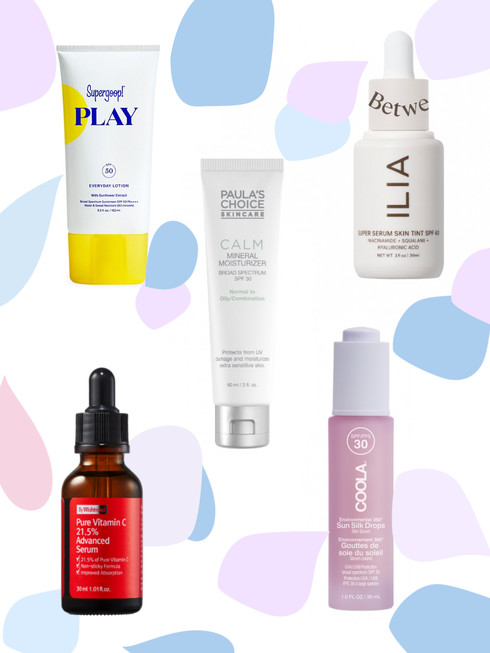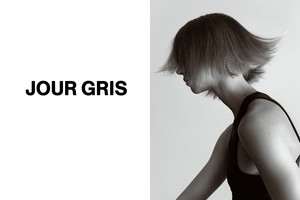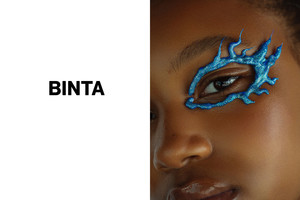Can we protect our skin from blue-light? If so, how?
Written by Yasmine by Fashion TalesPicture credits
photography Linda Andersson
hair and makeup Annie Ankervik
model Clara Hjerpe
What's blue-light?
Blue-light is the light that comes from our computers, smartphones, and TV screens. It’s a light most of us look at for hours each day. Not to mention, during the pandemic - my screen time at least, has gotten doubled - working from home with countless zoom meetings (and TV-series marathons).
Blue-light is not only the light that comes from our screens but is in the simplicity - a wave-length of the light spectrum that is longer compared to others. Which is why it penetrates the skin deeper than other lights in the same spectrum. With the increased exposure to blue-light, not only our eyes and sleep can get affected but our skin. Not to mention in a research study they saw that compared to UVB, the blue-violet light induced significantly more hyperpigmentation that lasted up to 3 months.
Furthermore, It has shown that 8 hours of screen time can be compared to 20 minutes of sun exposure. Which perhaps doesn't sound much, but as our face is closer to the source of light, it becomes more exposed.
d help us reduce the blue-light exposure.
A research paper from 2010 by the Department of Dermatology, Multicultural Dermatology Center, Henry Ford Hospital - scientifically showed that the more melanin you have in the skin, the more sensitive you are to blue-light and UV. Results showed that you could see pigmentation in the more melanin-rich skin than the lighter by UV light. So it’s not only lighter skin that has to use blue-light protection. Unfortunately, lighter skin types have often been the target market for sunscreen protection. However, that is changing rapidly with more awareness and focus on tinted mineral sunscreens and transparent sunscreens that don’t leave a light cast on the skin.
Following the information regarding that various wavelengths have different effects on skin pigmentation (2013), the study explains that using sunscreens against the entire visible light spectrum is almost impossible day to day. The results tell that though it’s difficult to protect from the shorter wavelengths it could be helpful to protect from those with the possibility for higher pigmentation - which suggests it’s better to protect our skin from the wavelengths we can - than not at all.
So how are we actually going to protect our skin?
It’s shown that ingredients such as zinc oxide and titanium dioxide can protect against blue-light damage, as they reflect light from our skin. Not to mention Vitamin C. Vitamin C is a good option to help pigmentation that can occur as a result of blue-light.
In addition, in an article from 2020, it is proved that tinted sunscreens can be a good choice for blue-light protection since it creates a visible layer of sunscreen instead of a white-cast. It demonstrated that tinted sunscreens that tinted sunscreens reduced transmittance of visible light more effectively than untinted sunscreens containing titanium dioxide or zinc oxide alone. Since the tinted sunscreen creates a visible protective layer, instead of using sunscreen that later goes into your skin. Results further showed that it didn’t matter what shade the product was. All shades had the same protection.
Last, always apply an antioxidant-loaded broad-spectrum sunscreen to keep skin shielded. It has been pretty challenging finding products that protect against blue-light - and after immense testing of products, the research continues to find ways that protect from blue-light. Here are the favorite products found so far:
By Wishtrend Pure Vitamin C 21.5 Advanced Serum
Vitamin C is said to neutralize reactive oxygen (free radicals) before they are created in our skin. Not to mention, Vitamin C helps with pigmentation, which can occur after being exposed to UVB/UVA lighting as well as blue-light. For that reason, adding Vitamin C to your skincare routine can help both neutralize free radicals and fade the appearance of pigmentation. By Whisttrends Pure Serum is highly concentrated Vitamin C drops. The serum does what a vitamin c serum is supposed to do, and makes your skin appear more luster and assist with pigmentation. It’s simply one of the best Vitamin C serums. However, if you are sensitive make sure you blend it with a toner or cream the first 2-3 times.
Coola Full Spectrum 360 Sun Silk Drops Organic Face Sunscreen SPF 30
Coola, is the new cool brand with focus on blue-light and sunscreen protection. The brand creates organic and vegan mineral sunscreens for UVA/UVB but also blue light. One of these products is the Sun Silk Drops. It has an oil-free formula that forms a transparent shield. The transparency makes it work for all skin tones. while it’s a mineral sunscreen, it doesn't leave a white cast. It’s made with 70% certified organic ingredients and a plant-derived Full Spectrum 360°, especially used by Coola that helps counter the effects of HEV light, infrared, blue light, and pollution. The only down part is that it ends too quickly for the price point- since you have to reapply your sunscreen during the day for the best protection.
Paula’s Choice CALM Mineral Sunscreen SPF 30
The CALM Mineral Sunscreen is a lightweight sunscreen with a broad spectrum.
Enriched with antioxidants and minerals to reduce inflammation and improve barrier function. It’s a mineral sunscreen, with apricot kernel oil that helps to strengthen the skin and as well as fight the signs of aging. It’s a good choice if you have dry skin since it’s a bit thicker in consistency. However, since it’s a mineral sunscreen - it gives a slight white cast, that takes a few minutes to disappear - and works into your skin. So, if you have a darker skin tone, it can be good to for example mix a little with your daily cream or I would recommend going for the Sun Silk Drops or tinted sunscreen with blue-light protection.
Supergoop! PLAY Everyday Lotion SPF 50
The Supergoop! is the sunscreen brand that has conquered the social sphere and become one of the most talked about sunscreens. Most importantly, finally available in Europe, through Cult beauty. They have a wide range of sunscreens for the face + body, in both chemical and mineral sunscreen to fit your skin type. One of the best-sellers is the PLAY SPF 50, which is a hydrating, fast-absorbing formula that protects from UVA, UVB, and IRA rays, while also said to prevent photoaging and dehydration. It’s additionally formulated to be water- and sweat-resistant for 80 minutes, which means we can wear it when we want to sport outside and still protect our skin. It’s also a great sunscreen to have under make-up and for that glowy no-makeup look.
ILIAs Super Serum Skin Tint SPF
Ilia is a sustainable beauty brand that took the beauty industry by storm a few years ago. But it hasn't got the recognition it deserves, at least here in the Scandinavian region. But I can almost be sure that this product can help change that. Their Super Serum Skin Tint is not only a great light foundation - it contains both zinc oxide and titanium dioxide to protect against blue-light with SPF 30. You apply it easily with your hands as the last step in your routine or you can use a foundation brush and leave your skin looking fresh and naturally covered. This product, I would say, is perfect for all skin tones since it comes in a wide range of shades. With that said, ILIA is a great option to protect against blue-light for darker skin tones.
CHPO Blue Light Glasses
Last but not least, after the article research regarding how our eyes can be affected by hours of blue light exposure, that results in interference with our sleep. We see the rise in blue-block glasses from various eyewear brands, one of these glasses are the stylish Blue Block glasses from the Swedish brand CHPO, which come in different designs and different colors from transparent to brown. Not to mention, they are from 100% recycled plastic.
With all of this information, I however still wonder, if we ever could truly protect our skin from blue-light and exposure except decreasing our screentime? If you have an answer for the blue-light problem - do let me know.
References
Can Light Emitted from Smartphone Screens and Taking Selfies Cause Premature Aging and Wrinkles?
Blue-Violet light irradiation
Impact of Long-Wavelength UVA and Visible Light on Melanocompetent Skin
Ultraviolet radiation and visible light both have biologic effects on the skin.
The growing incidence of photo damaging effects caused by UV radiation














